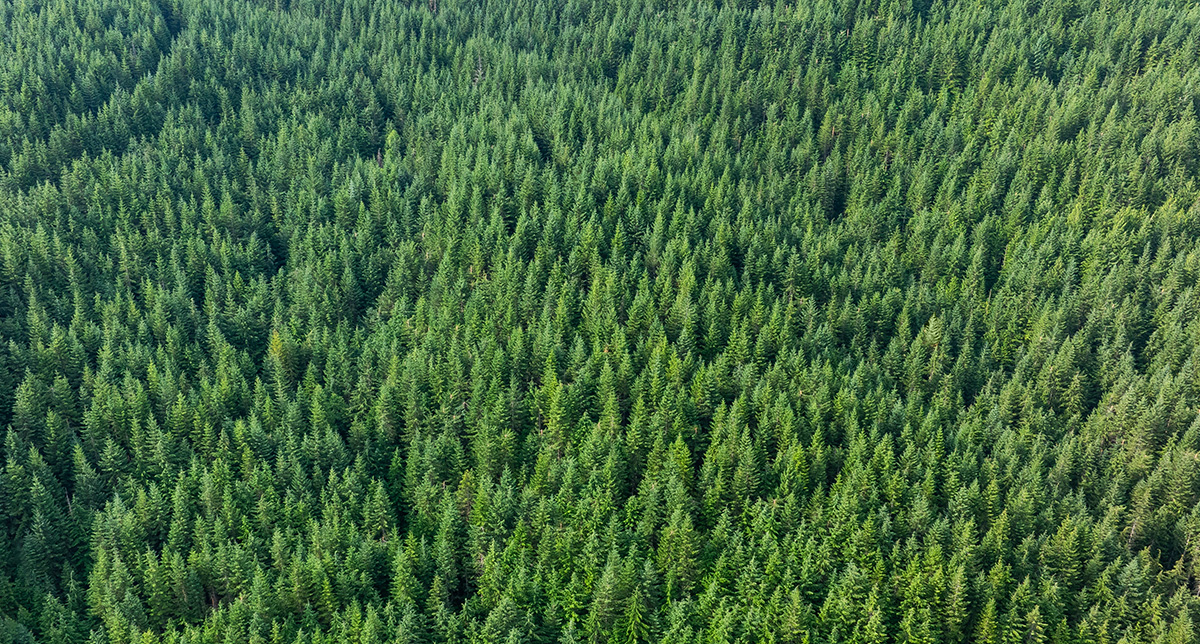
Since our early days, Weyerhaeuser has been a pioneer in lumber grading and stamping. These pieces of Douglas-fir lumber from our sawmill in Longview, Washington, show standard grade stamps, which include a mill-unique identifier, species, grade (here Select Structural and No. 1, our two highest grades), moisture content (surface-green in both cases), and the accrediting laboratory’s certification mark. The Fiber Sourcing website allows users to track regional fiber sourcing information by mill stamp.
A new website offers the public deeper insight than ever before into what’s happening in the forests where a wood product originated in the United States. Produced by the American Wood Council and launched this April, the new site (https://awc.org/wood-sourcing/) will help Weyerhaeuser and other forest products companies bring increased transparency to our fiber supply chain and its environmental sustainability practices.
It’s as simple as entering the grade stamp on a piece of lumber into the website, and customers and other end users can find information about the specific sourcing region that product came from, along with other regional forest facts.
Obtaining fiber from legal, responsible sources is a cornerstone our fiber procurement program. To ensure this is the case, our fiber sourcing teams regularly audit our suppliers to ensure they adhere to SFI fiber sourcing standard requirements. Here Chad Leatherwood (far left), Rick Cozine, Jared Richardson, Evan Gobble, Amy Phillips, Jason Bowman, Caleb Parker and Andi Flores audit a supplier’s property near our OSB mill in Elkin, North Carolina.
A PEEK BEHIND THE SOURCING LABEL
The need for this resource became clear to Ara Erickson, our vice president of Corporate Sustainability, and Katie Cava, Sustainability program manager, during the height of the COVID pandemic. They were participating in a series of virtual conferences and workshops with professionals such as architects, engineers and green building designers who specify wood for construction projects.
After a handful of these meetings, Ara and Katie realized there was an information gap about the practices in the forests where timber is grown that was creating hesitancy around using more wood products.
“Many specifiers, especially those involved in low- and zero-carbon construction products, wanted more detail on where their wood came from,” Ara says. “A forest certification or fiber-sourcing label wasn’t enough; they wanted a better understanding of what was actually happening on the specific landscape their wood product came from and how their decision to specify or use a certain type of wood product fits into an overall sustainable value chain.”
Unfortunately, without hard data, specifiers were often turning to individuals or organizations with strong and sometimes ill-informed opinions about forest products and forest management. The good news was that most specifiers were inclined to use wood, and the industry had regional fiber-sourcing data available — it just needed to be compiled into a consumable, user-friendly format.
Chad Leatherwood, Edwin Price, Avery Cauley, Gail Currie and Brett Lenyszyn audit a supplier's property near our sawmills in Greenville and Plymouth, North Carolina. The AWC Fiber Sourcing website provides builders, architects, engineers and others visibility into forest management practices by region.
AN INDUSTRY ISSUE
“This wasn’t a challenge specific to Weyerhaeuser, so we knew the full industry needed to be part of finding a solution,” Ara says. As an active participant in several trade and industry organizations, she began advocating for the development of a website to serve up the data specifiers wanted.
Within months, the Softwood Lumber Board and the U.S. Endowment for Forestry & Communities agreed to fund the creation of a pilot website that would be developed and hosted by the American Wood Council. AWC is a nonprofit industry group that advocates for sound policies, codes and regulations that encourage responsible manufacture and use of wood products.
BUILDING TRUST-BASED DATA
Katie represented Weyerhaeuser during the website’s development. The project’s overarching goal is to build trust in and maintain hard-won goodwill around using wood products.
“People want to use wood,” she says. “And they want to know it was sourced responsibly from noncontroversial sources and responsibly managed forests.”
That sourcing data exists as part of Sustainable Forestry Initiative® fiber sourcing or chain of custody certification. Member companies, including Weyerhaeuser, must know where their wood comes from and track whether their supplying forests are certified to a sustainability standard or responsibly managed.
“Making these data publicly available provides the missing link between the forest region a product originated from and the mill it’s created in,” Katie says. “We realized we could allow consumers and specifiers to access sourcing information specific to their purchased products using mill grade stamps, which have been added to every product we make for decades.”
Each grade stamp has a unique mill identification code. By entering the mill grade stamp number into the fiber-sourcing website, people can learn about the region where the wood in a product originated — such as the Pacific Northwest — and learn regional forest facts.
EXPANDING THE COMFORT ZONE
“The website empowers people to feel comfortable about using wood products,” Katie says. “Now that the pilot has launched, we’re excited about finding other ways to add additional detail and make the site even more valuable.”
The website currently includes sourcing data collected only from AWC member companies, which account for about 80 percent of the wood products manufactured in the United States (a similar website was developed by the Canadian Wood Council for products manufactured in Canada). AWC recently received a grant from the U.S. Forest Service to add data from nonmember companies.
And while there’s more to come, this first step is already making a difference.
“Wood is an exceptional product with a strong carbon and climate story,” says AWC’s Rachael Jamison. “Through this site, we can tell that story with data and numbers, and demonstrate the industry’s unparalleled commitment to transparency.”


